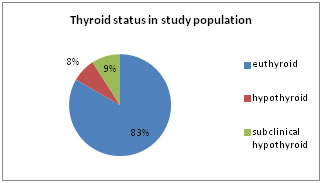Official Journals By StatPerson Publication
|
Table of Content - Volume 4 Issue 2 - November 2017
A study on prevalence of subclinical hypothyroidism in rural women
Smita Kottagi1*, Triveni Jambale2, Srinivas Deshpande3, Amareshwar Malagi4
1,2Assistant Professor, 3Professor, 4Associate professor, Department of Biochemistry, Gadag Institute of Medical Sciences, Gadag, Karnataka, INDIA. Email: smigaju@gmail.com
Abstract Background and Objectives: Subclinical hypothyroidism is diagnosed with increasing frequency in recent years. It is known to cause dearrangements in lipid, glucose metabolism and have been found to be associated with atherosclerosis and coronary heart disease. Subclinical hypothyroidism is now a day’s causing major controversies regarding its diagnosis, management and treatment. There are only few studies done to know the prevalence of subclinical hypothyroidism. This study was designed to estimate the prevalence of subclinical hypothyroidism in rural women. Materials and Methods: Totally 200 patients coming from rural areas were included in the study. Serums T3, T4, TSH were estimated by ELISA method. Results and Interpretation: From the total number of 200 patients enrolled in the study, 18(9%) patients are subclinical hypothyroid females and 16 (8%) patients are frank hypothyroid cases. Our study shows there is prevalence of subclinical hypothyroid cases-9% whereas the frank hypothyroid cases are 8%. Significant increase was found in the mean serum levels of TSH (P<0.001) Conclusion: The present study has identified that the prevalence of subclinical hypothyroidism in females is found to be 9%, which is more when compared to frank hypothyroidism Key Words: Subclinical hypothyroidism, hypothyroidism, prevalence rate.
Subclinical hypothyroidism is the condition with an elevated Thyroid Stimulating Hormone concentration (TSH) in the presence of normal serum thyroxine (T4), triiodothyronine (T3) concentrations1. Subclinical hypothyroidism is totally based on laboratory diagnosis,in which most of the patients are asymptomatic and present with no clinical signs and symptoms. previous studies have shown that the prevalence of subclinical hypothyroidism is more among female populations2. Studies have shown that nearly 2-5% of patients having subclinical hypothyroidism may progress to overt hypothyroidism. Subclinical hypothyroidism is associated with abnormalities of lipid metabolism, hip bone fractures, cognitive dysfunctions and pulmonary complications, atherosclerosis, coronary heart diseases.3-5 In case of females subclinical hypothyroidism is associated with Dysfunctional uterine bleeding, increased incidence of preeclampsia during pregnancy6,7. There are only few studies indicating prevalence of subclinical hypothyroidism in females in India. At present there are no standard protocols for screening, diagnosing, treating and follow up for patients with subclinical hypothyroidism. So stands the importance of the study to find the prevalence of subclinical hypothyroidism to plan the treatment and to prevent the complications associated with subclinical hypothyroidism.
MATERIALS AND METHOD The study was done in the Dept. of Biochemistry, BLDEU’S Shri. B. M. Patil Medical College Hospital and Research Centre, Bijapur (Karnataka) India. 200 patients coming from the rural areas were included, according to the inclusion and exclusion criteria considered for the study. This study was approved by the Institutional Ethics Committee. All the subjects gave an informed consent before undergoing further investigations. The study was carried out from November 2011 to May 2013. Inclusion Criteria: Serum TSH in the range of 4.50 to 14.99 mlU/L, T3 and T4 within normal limits were considered as subclinical hypothyroid cases. Serum TSH [0.3-4.5 mlU/L.] were considered as euthyroids. Exclusion Criteria: cases with known hypothyroidism, thyroidectomy cases, patient with radiotherapy, previous radioactive iodine therapy, consumption of drugs known to cause SCH, primary or secondary dyslipidemia, patients with diabetes mellitus, patients with other systemic illness, renal and hepatic failure cases, patients on statins were excluded from the study. Collection of blood samples: Venous blood samples were drawn at 8 a.m. following a 12 hours of fasting, in a plain bulb from the subjects, with all the aseptic precautions. Blood samples were centrifuged within 30 minutes at 3000 rpm for 5 min. and serum was separated. Serum samples were stored at -20°C until assayed. Serum T3, T4, TSH were estimated by ELISA method.8-10
RESULTS
Figure 1: Shows the distribution of thyroid status in the study population
Fig. 1 total number of 200 patients considered in our study, 18 (9%) patients were found to be females with subclinical hypothyroid.8% of the patients showed hypothyroidism and 83% were normal.
DISCUSSION Thyroid disorders are the commonest endocrine disorders especially involving the female population. Subclinical hypothyroidism is a disorder of thyroid gland that is totally dependent on laboratory results of thyroid profile rather than presenting with clinical signs and symptoms. It is found to be associated with dyslipidaemia, vascular, neurological complications11-13. Our study showed that the prevalence of subclinical hypothyroidism is 9% as compared to 8% in overt hypothyroidism. Our study is similar to the study done by Bashir H et al who studied prevalence of subclinical hypothyroidism in females in mountainous valley of Kashmir13. Our study is similar to the study done by Deshmukh V et al who studied Prevalence, clinical and biochemical profile of subclinical hypothyroidism in normal population in Mumbai have showed comparative results11. The study done by Usha Menon et al14 have showed that there is a high prevalence of subclinical hypothyroidism i.e. 9.4% their study also showed that the prevalence increased with increasing age. Tunbridge et al15 studied Spectrum of Thyroid disease in a Community and found out that 10.3% and 0.3% were suffering from subclinical and overt hypothyroidism, respectively. There study showed a little increase in the prevalence compared to our study.
CONCLUSION The present study has identified that the prevalence of subclinical hypothyroidism in females is found to be 9%, which is more when compared to frank hypothyroidism. This shows the importance of screening the patients with subclinical hypothyroidism so as to prevent them from going in for overt hypothyroidism. This early detection can help in proper management and preventing the patient from complications related to sub clinical hypothyroidism.
REFERENCES
|
 Home
Home

